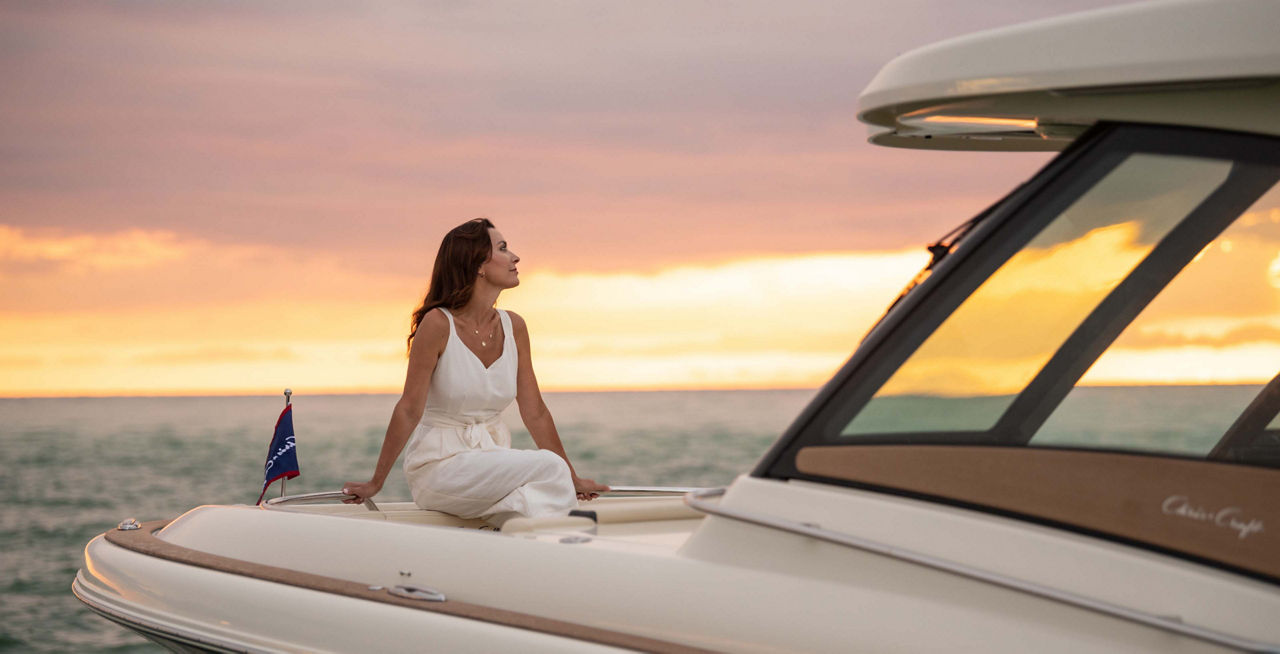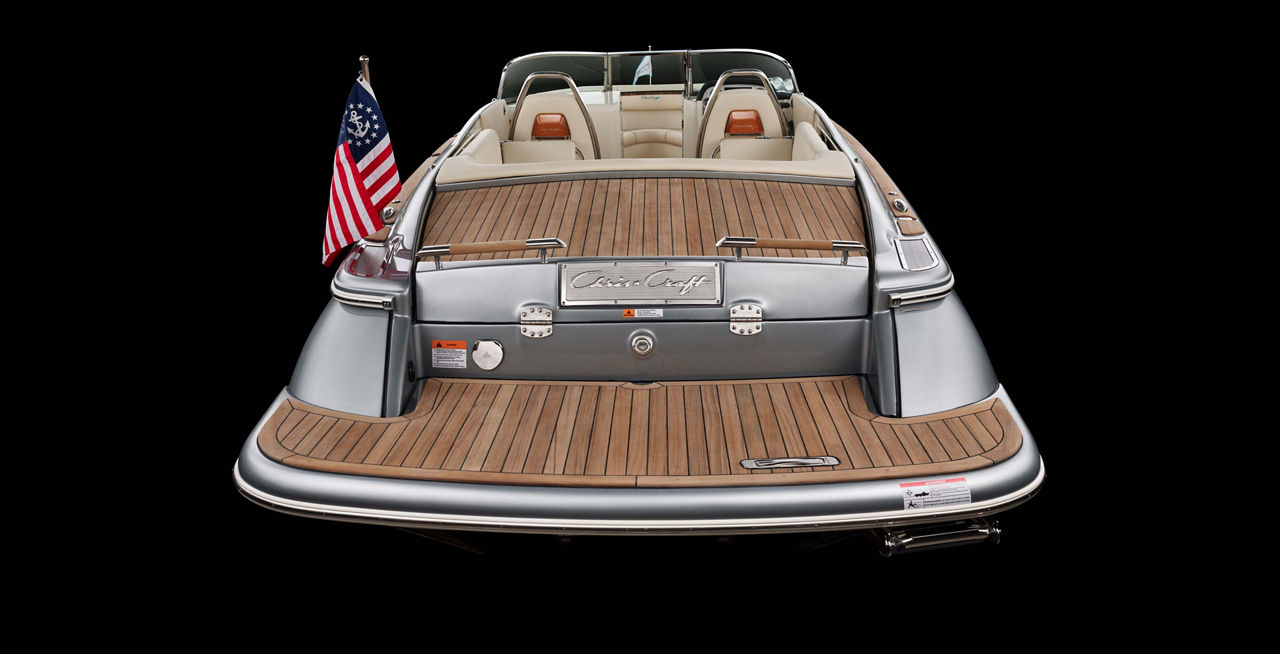- CRAFTSMANSHIP
- HERITAGE
- OWNERS
OUR CRAFTSMANSHIP
Each Chris-Craft boat is brought to life by highly experienced craftsmen at our
factory in Sarasota, Florida, where we maintain the highest standards for every detail. Our design ethos centers around timeless beauty and complete comfort. And we build our boats to look like no others, using only the highest-quality materials to set each Chris-Craft boat apart from the crowd.
DEDICATED ARTISANS
Many of our boatbuilders have been with Chris-Craft for decades – and all are the most-skilled carpenters, cabinetmakers, joiners, and artisans in the boatbuilding business. Their extensive knowledge, combined with the highest-quality materials, helps ensure your boat will be unlike any other on the water.


GENUINE TEAK
Our inlaid teak is handcrafted and caulked by skilled craftsmen. We use epoxy to eliminate fittings that might slowly rise up over time and create an eyesore or tripping hazard. Caulking the teak is a time-consuming art, but well worth the results. It’s all applied by hand, chiseled clean, and sanded to a smooth finish.

CUSTOM UPHOLSTERY
Chris-Craft upholstery starts with exceptional design. Wide bolsters. Distinctive stitching. And only the highest-quality, soft and luxurious marine vinyl – hand-selected for its resistance to fading, tears, stains, and punctures. From aligning seams to matching patterns and much more, Chris-Craft artisans see to each and every detail.
UNIQUELY FINISHED
Our building practice differs in that all of our hulls – including our classic tumblehome shape – are formed using a six-step lamination process that includes gelcoating by hand. Even our boot stripes are hand-coated, making them integral to the fiberglass. Each boat goes through a rigorous 50-hour painting methodology.

OUR HERITAGE
Since the beginning, the boats crafted by Christopher Columbus Smith and his successors have brought dreams to life. Over the years, Chris-Craft boats have become cultural icons in their own right, empowering people with the freedom to explore their local lakes and distant shores. Chris-Craft has been nurturing America’s romance with boating for over 150 years.
LATE 1880s
BIRTH OF AN ICON
The small town of Algonac, Michigan, is where 13-year-old Christopher Columbus Smith built his first boat in 1874. Referred to as punts or skiffs, his boats quickly earned him a reputation as a master boatbuilder. As demand grew, Chris soon joined forces with his brother, Hank, and began producing full time, laying the groundwork for their future as builders of “standardized” runabouts.

EARLY 1900s
ERA OF EXPANSION
The Smith Ryan Boat Company, officially formed in 1910, focused on building fast, economical runabouts for the masses. After a name change to the Chris Smith & Sons Boat Company, Jay Smith (Chris’s son) was named President and General Manager in 1927. During his 31 years of leadership, Chris-Craft would become known as the world’s largest builder of mahogany powerboats.

MID 1900s
SUPPORTING OUR TROOPS
As sales dipped during the Great Depression, the company returned to building runabouts, but helping the country quickly became our focus during World War II. Chris-Craft built patrol boats, utility launches, and rescue vessels for the U.S. Navy and Army, delivering 12,000 vessels by 1945. After the war, our powerboat lineup would reach 139 models, and our first fiberglass boat debuted in 1955.

LATE 1900s
RETURNING TO OUR PASSION
1971 marked the end of an era, as we built our last mahogany boat — a 57-foot Constellation.™ Throughout the ’80s and early ’90s, Chris-Craft returned to our pre-wartime passion: sport boats. We built high-performance racing catamarans and began designing performance boats for our traditional customers, as well.

EARLY 2000s
DAWN OF A NEW CENTURY
Chris-Craft was purchased by an investment group in 2001, and we headed into the new century with exciting plans for expansion, including the introduction of three new Heritage models and a 43-foot Roamer yacht.

2024 & BEYOND
FUTURE FOCUSED
Chris-Craft vessels have captivated boat lovers from around the world for generations. Today, our entire company is dedicated to preserving the beauty and unparalleled craftsmanship that help define this legendary brand. We’re investing in new technologies and expanding our range of designs in our mission to keep delivering an exceptional and unrivaled boating experience.

CHRIS-CRAFT THROUGH THE YEARS
OUR OWNERS
Chris-Craft owners are at the heart of all we do. Those inspired to join our exclusive family of premium boat owners become a part of our heritage, embracing the iconic status of the Chris-Craft reputation as a brand that represents America, classic elegance, design excellence, and craftsmanship. Our legendary quality, reliability, and client service standards add up to an exceptional ownership experience.
STAY IN THE KNOW

CHRIS-CRAFT INTRODUCES NEW CATALINA 31 AT PALM BEACH BOAT SHOW
The newest Chris-Craft offering in the Catalina line showcases modern design, enhanced comfort, and innovative features

CHRIS-CRAFT RECOGNIZED FOR CUSTOMER SATISFACTION EXCELLENCE
Chris-Craft has been recognized with a 2024 Customer Satisfaction Index (CSI) Award by The National Marine Manufacturers Association (NMMA) for the 17th year in a row.

CHRIS-CRAFT ANNOUNCES DEBUT OF SPORTSTER 28 OUTBOARD
Chris-Craft debuts the Sportster 28 bowrider in an outboard configuration to consumers for the first time at the 2025 Miami International Boat Show

CHRIS-CRAFT RECOGNIZES TOP DEALERS DURING 150th ANNIVERSARY CELEBRATION
Boatbuilder hosts over 150 dealership personnel during a 3-day conference in its hometown of Sarasota, FL.

CHRIS-CRAFT INTRODUCES NEW SPORTSTER 25
Newest design offers boat brand’s ultra-premium quality and materials thoughtfully engineered at a competitive price point.

RELEASE OF SPECIAL 150TH ANNIVERSARY EDITION
Chris-Craft is celebrating their 150th anniversary with the release of a special anniversary edition. The anniversary edition Launch 27 pays homage to the brand’s legacy of pleasure boating.
THE CHRIS-CRAFT LIFESTYLE
Whether you’re in the mood to freshen your own boating wardrobe with some Chris-Craft essentials or seeking the perfect gift for a fellow boating enthusiast, we have you covered with the Chris-Craft Collection. Select from a variety of modern and vintage graphics on comfortable hoodies, classic crew necks, totes, drinkware, pet gear, boat accessories, and more.

TEAK TIPS
The natural oils in teak, along with regular cleanings, will help preserve your decks far into the future. A clean cloth or paper towel can be used to wipe up spills from suntan lotion, motor oil, or oily foods. To remove stains and pollutants, rinse decks regularly with fresh water or mild cleansers. While cleaning, scrub only across the grain with a soft-plastic c-bristle brush. A teak sealer may be applied if you wish to maintain the deck’s appearance. Use of teak oils is not recommended.
UPHOLSTERY CARE
Beneath the luxurious marine-grade vinyl upholstery, all Chris-Craft seating is designed with drain holes to eliminate water retention. We also treat our vinyl and our triple-density seat foam with an antimicrobial agent to help prevent mildew. Additionally, the vinyl is finished with a Permagard Premium Topcoat for protection against stains and abrasions.


PAINT PRESERVATION
Our extensive selections of non-metallic and metallic paints are designed to go beyond the gel-coat color offering to provide our owners with the opportunity to create a boat that is customized down to the very last detail. A true multi-step process, our hulls are primed and painted under the constant care and attention of our skilled team. Our finish creates a durable layer protecting the paint, allowing for years of brilliant color.

CELEBRATING ANTIQUES & CLASSICS
We encourage owners of antique and classic Chris-Craft boat models to explore the Chris-Craft Antique Boat Club (CCABC). Chris-Craft is proud to sponsor and be a part of this elite society. The CCABC provides access to parts, layouts, and selling information for classic models and can assist with other questions this special group of owners may have.












































